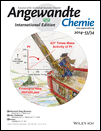Selective Formation and Unusual Reactivity of Tetraarsabicyclo[1.1.0]butane Complexes†
This work was supported by the Deutsche Forschungsgemeinschaft (DFG). C.S. is grateful for a Ph.D. fellowship of the Fonds der Chemischen Industrie.
Graphical Abstract
As a butterfly: The selective formation of the dinuclear butterfly complexes [{Cp′′′Fe(CO)2}2(μ,η1:1-E4)] and [{Cp*Cr(CO)3}2(μ,η1:1-E4)] (E=P, As) results from the reaction of E4 with the corresponding dimeric carbonyl complexes. The As complexes are the first As4 butterfly compounds with a bridging coordination mode. First studies of their reactivity show the formation of unprecedented As8 cuneane complexes.
Abstract
The selective formation of the dinuclear butterfly complexes [{Cp′′′Fe(CO)2}2(μ,η1:1-E4)] (E=P (1 a), As (1 b)) and [{Cp*Cr(CO)3}2(μ,η1:1-E4)] (E=P (2 a), As (2 b)) as new representatives of this rare class of compounds was found by reaction of E4 with the corresponding dimeric carbonyl complexes. Complexes 1 b and 2 b are the first As4 butterfly compounds with a bridging coordination mode. Moreover, first studies regarding the reactivity of 1 b and 2 b are presented, revealing the formation of the unprecedented As8 cuneane complexes [{Cp′′′Fe(CO)2}2{Cp′′′Fe(CO)}2(μ4,η1:1:2:2-As8)] (3 b) and [{Cp*Cr(CO)3}4(μ4,η1:1:1:1-As8)] (4). The compounds are fully characterized by NMR and IR spectroscopy as well as by X-ray structure analysis. In addition, DFT calculations give insight into the transformation pathway from the E4 butterfly to the corresponding cuneane structural motif.





